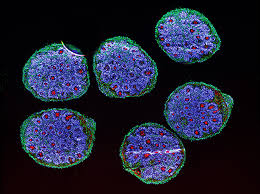Human Brain Organoids Model Abnormal Prenatal Neural Development Induced by Thermal Stimulation
The developing human foetal brain is sensitive to thermal stimulation during pregnancy. However, the mechanisms by which heat exposure affects human foetal brain development remain unclear, largely due to the lack of appropriate research models for studying thermal stimulation. To address this, we have developed a periodic heating model based on brain organoids derived from human pluripotent stem cells. The model recapitulated neurodevelopmental disruptions under prenatal heat exposure at the early stages, providing a paradigm for studying the altered neurodevelopment under environmental stimulation.
Our study found that periodic heat exposure led to decreased size and impaired neural tube development in the brain organoids. Bulk RNA-seq analysis revealed that the abnormal WNT signalling pathway and the reduction of G2/M progenitor cells might be involved in heat stimulation. Further investigation revealed increased neural differentiation and decreased proliferation under heat stimulation, indicating that periodic heat exposure might lead to abnormal brain development by altering key developmental processes.
Hence, our model of periodically heating brain organoids provides a platform for modelling the effects of maternal fever on foetal brain development and could be extended to applications in neurodevelopmental disorders intervention.
Maternal fever during pregnancy may induce thermal stress in both the mother and foetus, potentially resulting in embryonic death, structural and functional defects or reduced growth. The developing brain during pregnancy is sensitive to thermal damage, and the specific phenotype depends on the increase and duration of maternal temperature, as well as the developmental stage of thermal damage. Prospective and retrospective epidemiological investigations have underscored a potential association between early gestational hyperthermia and abnormal brain development, including neural tube defects (NTDs), brain atrophy and neuronal ectopia. Therefore, heat exposure during pregnancy may lead to irreversible changes in the structure and function of the developing foetal brain.
Animal experiments across various species have demonstrated that prenatal exposure to heat stress is associated with a series of detrimental outcomes to the foetal brain, including a decrease in brain weight, abnormal neurogenesis, microcephaly, and NTDs. These findings highlight the critical impacts of maternal thermal conditions on neurodevelopmental trajectories in offspring. However, due to the lack of human brain development models, studies on the mechanism by which heat stress altered brain development are limited. It is difficult to quantitatively extrapolate from animals to humans due to species differences, even different sensitivities and thresholds for hyperthermia-induced teratogenicity were shown within a species but different genotypes or strains. The demand to establish in vitro models of prenatal foetal brain development has become increasingly urgent .
Benefited by the development of human pluripotent stem cells (hPSCs), 3D-cultured human brain organoids could model the endogenous microenvironment and biological processes of multifarious cells. Hence, brain organoids are widely used as in vitro models for toxicity tests including alcohol, nicotine and various viruses, as well as for studying different neurological diseases, especially in modelling diseases related to prenatal brain development. Therefore, brain organoids may provide an opportunity for modelling the effects of hyperthermia during pregnancy on human foetal brain development in vitro.
Here, we proposed a strategy to use human brain organoids derived from hPSCs as developing foetal brain models to undergo periodic heat exposure at 40°C to model the influence of maternal fever on foetal brain development. We found that brain organoids indicated a diminution in size and impaired neural tube development after periodically heating. Subsequent bulk RNA-seq unveiled upregulation of the WNT signalling pathway and neural differentiation transcription factors, coupled with a decline in G2/M progenitors in brain organoids after thermal stimulation. We thus confirmed that thermal damage led to attenuated proliferative activity within the ventricular zone (VZ) and augmented neural differentiation in the organoids. The proposed scheme of periodically heating brain organoids could offer a platform for research on mechanisms and drug screening in the study of foetal neurodevelopmental disorders (NDDs).
human brain organoids, brain development, neural stem cells, cerebral organoids, 3D brain models, brain tissue engineering, neurogenesis, brain disease modeling, neurological disorders, brain-on-a-chip, iPSC-derived organoids, brain maturation, brain microenvironment, brain connectivity, neural circuits, mini-brains, brain organoid culture, brain aging studies, brain regeneration, neuropharmacology
#HumanBrainOrganoids, #BrainDevelopment, #NeuralStemCells, #CerebralOrganoids, #3DBrainModels, #BrainTissueEngineering, #Neurogenesis, #BrainDiseaseModeling, #NeurologicalDisorders, #BrainOnAChip, #iPSCOrganoids, #BrainMaturation, #BrainMicroenvironment, #NeuralCircuits, #MiniBrains, #BrainOrganoidCulture, #BrainAging, #BrainRegeneration, #Neuropharmacology, #StemCellResearch
International Conference on Genetics and Genomics of Diseases
Visit: genetics-conferences.healthcarek.com
Award Nomination: genetics-conferences.healthcarek.com/award-nomination/?ecategory=Awards&rcategory=Awardee
Award registration: genetics-conferences.healthcarek.com/award-registration/
For Enquiries: contact@healthcarek.com
Get Connected Here
---------------------------------
---------------------------------
in.pinterest.com/Dorita0211
twitter.com/Dorita_02_11_
facebook.com/profile.php?id=61555903296992
instagram.com/p/C4ukfcOsK36
genetics-awards.blogspot.com/
youtube.com/@GeneticsHealthcare

Comments
Post a Comment